
The Ethereum network had its cheapest day in over six months, which could suggest altcoins could rally “sooner than many may expect.”
Cryptocurrency Financial News

The Ethereum network had its cheapest day in over six months, which could suggest altcoins could rally “sooner than many may expect.”
Ethereum withdraws from centralized exchanges have ramped up over the last week, suggesting a direction for investor sentiment during this time. Given the sheer volume of ETH withdrawn from these exchanges, it is prudent to try to understand what this could mean for the crypto’s price.
Amid the uncertainty that has plagued the crypto market, Ethereum investors are making moves to secure their positions for better price prospects. Pseudonymous crypto technical analyst Titan of Crypto took to X (formerly Twitter) to share what Ethereum investors are doing about their holdings right.
Related Reading: Bitcoin Bears Risk Losing $7.2 Billion If BTC Price Reaches This Level
The post revealed that these investors have been withdrawing large amounts of ETH from centralized exchanges. In the one week period that was tracked, the report found that a total of 260,000 ETH were withdrawn from exchanges, which was worth almost $800 million at the time.
Crypto exchanges witnessed an outflow of over 260,000 #ETH equivalent to more than $781 million within the past 7 days.
It’s time for #Ethereum shine.
pic.twitter.com/jT1aocjvbI
— Titan of Crypto (@Washigorira) April 24, 2024
Now, exchange deposits and withdrawals are important for any cryptocurrency because it can often tell how investors are looking at that coin and what they are doing with their holdings. In the case of large deposits to centralized exchanges, it can be very bearish for the price because investors often deposit their coins in order to sell them as exchanges provide deep liquidity.
In contrast, withdrawals from exchanges suggest that investors are not looking to sell their ETH. Rather, they are accumulating the coins to wait for better prices before selling. Naturally, this is bullish for the Ethereum price as a diminished selling pressure gives room for the price to recover.
In this case, the withdrawals are bullish or the Ethereum price, as investors continue to accumulate. It also signals that investors are expecting a price breakout, and as the withdrawals ramp up, demand could surpass supply, leading to a surge in price.
Ethereum, while currently seeing some positive activity from investors, has still not turned completely bullish. For one, there has been a significant decline in its daily trading volume. According to data from Coinmarketcap, Ethereum’s trading volume is down approximately 20% in the last day.
This decline in volume suggests a declining interest from investors to actually trade the coin. As such, its price may be negatively affected as attention begins to shift elsewhere, with investors looking for better prospects.
Nevertheless, the cryptocurrency still looks bullish for the long term. Ethereum continues to closely mirror the price performance of Bitcoin, which is expected to go on a bull run following the successful completion of its fourth halving event.
For now, Ethereum continues to struggle to hold above $3,100 with small gains of 0.18% in the last day. Over the last month, it has suffered multiple crashes, registering a 12.36% loss in the last 30 days.
The second-largest crypto token by market cap, Ethereum (ETH), looks set to make a massive market recovery following recent buys suspected to be made by Tron’s founder, Justin Sun. Sun’s accumulation spree again highlights crypto whales’ recent bullishness on Ethereum despite fluctuating prices.
In an X (formerly Twitter) post, the on-chain analytics platform Lookonchain drew the crypto community’s attention to a mysterious wallet suspected to belong to Justin Sun. This wallet is said to have bought 127,388 ETH ($405.19 million) from Binance and decentralized exchanges (DEXs) since April 8 at an average price of $3,127.
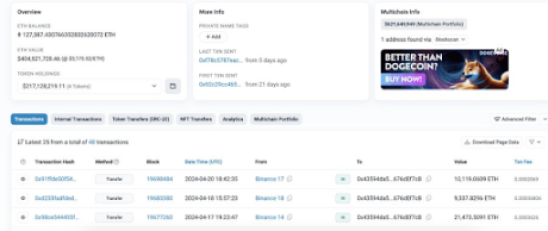
Meanwhile, Lookonchain tried to prove further its theory that this wallet likely belonged to Justin Sun. The platform alluded to a previous tweet mentioning that a suspected Justin Sun wallet bought 168,369 ETH at $2,894 from Binance and a DEX between February 12 and 24. It noted that the “transaction behavior” of both wallets was similar, which suggests that they are both likely owned by Justin Sun.
If indeed both wallets are owned by Justin Sun, that means the Tron founder has accumulated 295,757 ETH ($891 million) at an average price of $3,014 since February 12. Like every whale activity, Sun’s alleged transactions have caught the crypto community’s attention, with many wondering why he is gaining so much exposure to the second-largest crypto token.
Sun’s actions highlighted the bullish sentiment that Ethereum whales have towards the crypto token despite its recent unimpressive price action. Bitcoinist recently reported about an Ethereum whale who, despite already losing $4.5 million, opened another long position on the second-largest crypto token.
This whale also borrowed 17.3 million USDT just to increase their exposure to the crypto token. In a recent X post, Lookonchain again highlighted how Ethereum whales are still making bullish moves in the market. On-chain data shows a fresh wallet (0x9EB0) that withdrew 7,182 ETH ($23.06 million) from Binance, which suggests long-term holding by this whale.
Another wallet (0x1958) withdrew 5,181 ETH ($16.28 million) from Binance and put their ETH holdings to work by staking it into Bedrock and Pendle while anticipating further price gains in the crypto token.
Such bullish sentiment towards Ethereum could be good for ETH’s price as whales are known to have a significant impact on a token’s price discovery. It could also prove crucial during this period when Ethereum is experiencing declining network growth, which means that the rate at which new users come into the ecosystem has slowed.
At the time of writing, Ethereum is trading at around $3,170, down over 1% in the last 24 hours, according to data from CoinMarketCap.
The crypto market has been plagued with increased volatility lately, with the second largest crypto token by market cap, Ethereum (ETH), not exempt. This has made it harder to determine Ethereum’s future trajectory. However, certain metrics indicate what direction ETH’s price could head in when this volatility subsides.
Data from Coinglass shows that most Ethereum investors and traders are still bullish on the crypto token despite recent fluctuating prices. Specifically, most of these traders have continued to open long positions on Ethereum, meaning they are betting on it experiencing significant moves to the upside in the long run.
The bullish sentiment towards Ethereum is highlighted by a trader who, having lost $4.5 million while longing ETH, still opened another long position on the second-largest crypto token. This crypto whale went as far as borrowing 17.3 million USDT from Compound just to increase their position on Ethereum.
These investors’ bullishness on Ethereum is even more commendable, considering that the bulls have suffered the most from ETH’s high volatility. Data from Coinglass shows that over $16 million in long positions have been liquidated in the last 24 hours, compared to the $10 million short positions that have liquidated during this period.
Meanwhile, data from the market intelligence platform IntoTheBlock shows that Ethereum’s Market Value to Realized Value (MVRV) ratio has dropped, indicating that many Ethereum holders are not yet in profit. This could be bullish for ETH’s price as these holders will likely hold in anticipation of further upward price action, thereby providing support against any potential price declines.
While the activity in the derivates market and Ethereum’s MVRV ratio paint a bullish outlook for the crypto token, Ethereum’s network growth suggests that ETH could still experience further price declines. Data from Santiment shows that the rate at which new users enter the Ethereum ecosystem has slowed recently.
This declining network growth is also evident in a recent Bitcoinist report, which noted that Ethereum fees have dropped to their lowest since January. Ethereum fees are known to skyrocket when there is increased activity on the network. Therefore, low fees mean fewer new users are currently transacting on the network or even holding the ETH token at all.
However, the silver lining is that data from Santiment also shows an increase in velocity, which suggests that existing users on the network are actively trading and injecting more liquidity into the Ethereum ecosystem. This factor could also contribute to potential price surges for the ETH token.
At the time of writing, Ethereum is trading at around $3,200, which is up in the last 24 hours, according to data from CoinMarketCap.
Not only has Ethereum (ETH) seen an impressive rise of nearly 100% in the first quarter of 2024 in terms of price action, but the Ethereum blockchain has also generated substantial profits of up to $369 million during this period. This unexpected profitability has raised questions about how a blockchain like Ethereum can be profitable.
As noted in a recent analysis by the on-chain data platform Token Termina, the collection of transaction fees is a critical aspect of Ethereum’s business model.
All network users are required to pay fees in ETH when interacting with applications on the blockchain, which serves as an important source of revenue for Ethereum.
Once transaction fees are paid, a portion of the ETH is burned and permanently removed from circulation. This process, commonly referred to as “ETH buyback,” benefits existing ETH holders, as the reduction in supply increases the scarcity and value of the remaining ETH tokens. Thus, the daily burning of ETH contributes to the economic benefit of those holding Ethereum.
In contrast to the burning of ETH, Ethereum also issues new ETH tokens as rewards to the network’s validators for each new block added to the blockchain.
These rewards are similar to traditional stock-based compensation and are designed to incentivize validators to secure and maintain the network’s integrity.
Nonetheless, it’s important to note that the issuance of new ETH tokens dilutes the holdings of existing ETH holders.
According to Token Terminal, the difference between the daily USD value of the burned ETH (revenue) and the newly issued ETH (expenses) represents the daily earnings for existing ETH holders, essentially the Ethereum blockchain owners. This calculation allows for the determination of Ethereum’s profitability on a day-to-day basis.
In addition to the overhauled revenue model implemented by the Ethereum blockchain, the launch of the much-anticipated Dencun upgrade to the Ethereum ecosystem at the end of the first quarter of 2024 brought significant changes, including the introduction of a revolutionary data storage system called blobs.
This upgrade has reduced congestion on the Ethereum network and significantly reduced transaction costs on Layer 2 networks such as Arbitrum (ABR), Polygon (MATIC), and Coinbase’s Base.
Implementing the Dencun upgrade, alongside the adoption of blobs and Layer 2 networks, has significantly impacted Ethereum’s revenue.
According to Token Terminal data, the blockchain’s revenue has witnessed an 18% annualized increase, amounting to an impressive $3.3 billion. These revenue gains can be attributed to reduced transaction costs, making Ethereum a more attractive platform for users and developers.
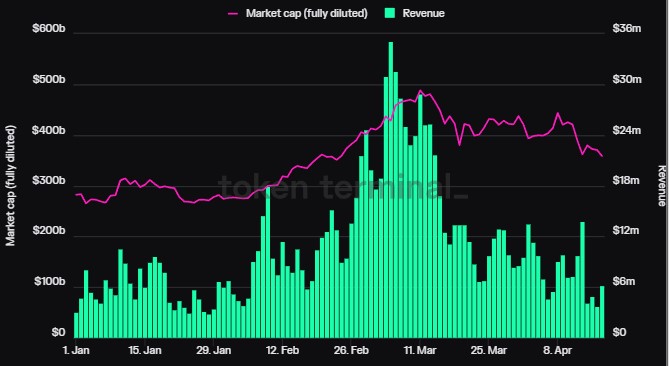
Despite the positive revenue growth, it is essential to acknowledge the impact of market corrections and dampened investor interest in the second quarter of 2024.
Over the past 30 days, Ethereum’s revenue has declined by over 52%. This downturn can be attributed to the broader market dynamics and the temporary decrease in investor enthusiasm.
Examining the data over the past 30 days, Ethereum’s market cap (fully diluted) has decreased by 15.2% to $358.47 billion. Similarly, the circulating market cap has declined by 15.2% to reach the same value.
Additionally, the token trading volume over the past 30 days has declined 18.6%, totaling $586.14 billion.
ETH is trading at $3,042, up 0.4% in the last 24 hours. It remains to be seen whether these changes and the reduction in fees will have the same effect in the second quarter of the year, and how this, coupled with a potential increase in trading volume, can push the ETH price to higher levels.
Featured image from Shutterstock, chart from TradingView.com
Crypto analyst CrediBULL Crypto has laid out a bullish narrative for Ethereum (ETH) and XRP. He claimed that both tokens could rise to as high as $20,000 and $20, respectively. Additionally, he stipulated when this parabolic price surge is likely to happen.
CrediBULL Crypto mentioned in an X (formerly Twitter) post that there is a chance that Ethereum could hit a market peak near $20,000. He further explained that ETH could attain this price level based on his belief that BTC can “realistically” see a 2x in this market cycle from its last high of $69,000 in the 2021 bull run. As such, altcoins like ETH will do “multiples of that.”
Specifically, he foresees ETH doing a 3x to 4x of its prior all-time high (ATH) of $4,800, which puts the second largest crypto token by market cap in a price range between $15,000 and $20,000. Meanwhile, CrediBULL asserted that Ethereum will surely rise to $10,000 at the minimum.
Following CrediBULL’s prediction, another X user questioned how possible it was for ETH to rise to a market cap of $2 trillion, stating that it seems “crazy.” However, the crypto analyst responded that ETH rising to such levels is a “blow off top, ” so the market cap will look “outrageous.” He jokingly added that there is a problem if the market caps don’t look outrageous.
In a different X post, CrediBULL also made a case for XRP, stating that XRP could also rise between $10 and $12 if ETH were to hit $10,000. He suggested that XRP wasn’t to be underrated despite its current underperformance, noting that XRP actually flipped ETH in terms of market cap at some point in the last cycle.
Therefore, the crypto analyst added that anyone who thinks ETH hitting $10,000 is “realistic” should also believe that XRP rising to $10 is possible. In a subsequent X post, CrediBULL claimed that XRP could even rise to as high as $20 based on ETH hitting $10,000 at its current circulating supply.
Again, he noted that XRP is very capable of attaining such price levels, seeing as it is a top 10 coin, which means that the market demand for it is evidently there. CrediBULL’s sentiment echoes that of Nick, the founder of Web3Alert, who previously predicted that XRP could rise to $10 since there were predictions that Bitcoin and Ethereum would rise to as high as $150,000 and $10,000, respectively.
At the time of writing, ETH and XRP are trading at around $3,290 and $0.58, according to data from CoinMarketCap.
Altcoins like Ethereum, Cardano, Solana, and the rest might be lower at spot rates. However, according to one analyst who sees a parallel in the current formation to the 2020 market cycle, they are gearing up for a potential surge.
In a post on X, the analyst says that often, after a period of accumulation and a retest of previous highs, altcoins tend to be volatile. The crypto analyst also notes that Bitcoin has pulled back from its all-time highs and is preparing for a possible retest of this level registered in March.
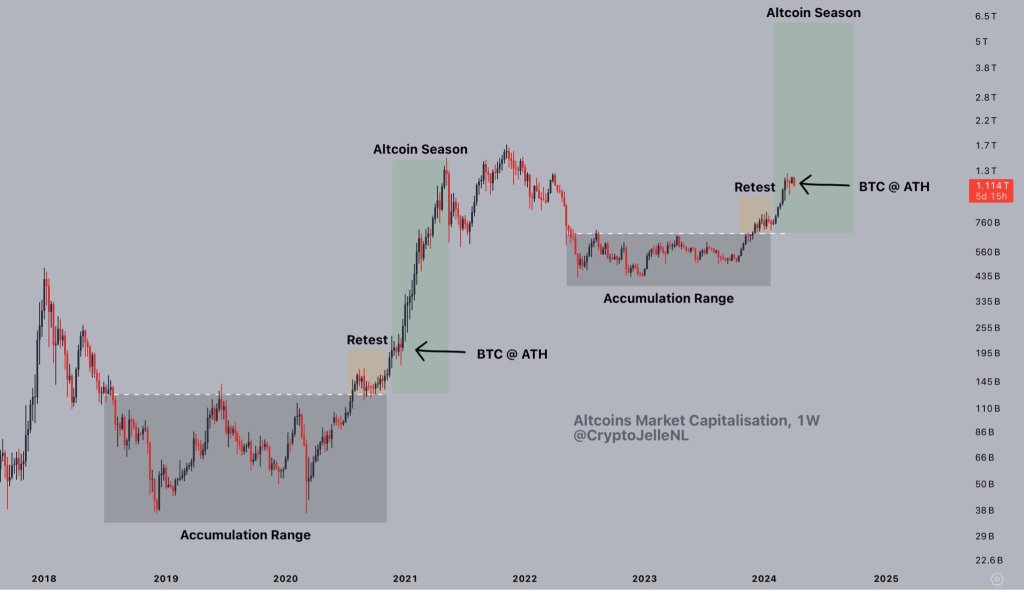
Though altcoins have been decimated, looking at price action in the past 24 hours, altcoins are on a bullish path, similar to the last cycle registered in 2020. The analyst says Bitcoin will catalyze the altcoin swing to fresh levels and valuations.
For now, it is hard to predict the exact valuation of top altcoins. However, the analyst notes a similar formation in the current price action.
When altcoins consolidated after surging, prices tended to recover strongly. This spike was evident, especially once Bitcoin broke through critical liquidation levels and entered “price discovery” or fresh all-time highs.
Currently, Bitcoin is in this position. The coin is trading lower and cooling off from all-time highs. Even after higher highs last week, bulls didn’t break the $71,700 level in the daily chart. With BTC collapsing, altcoins also fell, with Ethereum, Solana, and top coins slipping below support levels.
The altcoin season might come earlier this time, especially once Bitcoin recovers. Possible triggers include the upcoming Bitcoin halving event. Analysts claim that halving will likely create a supply crisis, causing scarcity. If institutions funnel the same demand level, BTC will likely rip higher, breaking $71,700 and even $73,800 all-time highs.
Beyond this, upcoming network upgrades in Ethereum, like the recently mentioned “Purge” and Firedancer integration in Solana, might trigger demand. Developers are working towards Voltaire in Cardano. All these changes plan to make the top smart contracts platform more reliable and enhance performance.
Besides network upgrades, analysts are considering the possible approval of spot Ethereum exchange-traded funds (ETFs). If the United States Securities and Exchange Commission (SEC) approves this product, ETH might benefit by lifting others. It might also accelerate the drafting of fitting laws, especially now that BlackRock thinks tokenization and real-world assets (RWAs) are the future of finance.
Ethereum has, for the most part, established a foothold above the $3,500 price level throughout the week as investors continue to anticipate a return to the $4,000 mark. Interestingly, the optimism has seen the open interest of Ethereum surging to new highs. The surge in open interest, although a bullish sentiment indicator, can also serve as a bearish signal of an impending change in market trend.
Ultimately, this metric added to the current dynamics of the Ethereum ecosystem, including regulatory uncertainty and scalability concerns hinting at a complicated price trajectory for the price of Ethereum.
Open interest is an efficient method for tracking the total number of open positions in a particular contract. Recent market dynamics and institutional investor interest have seen the total open interest in Ethereum futures surging above records set in the 2021 bull market phase.
According to data from Coinglass, the open interest on Ethereum futures, which has been on a surge since February 5, recently set a new high of $14.11 billion on March 15. This wasn’t particularly surprising, as a strong buying momentum from the bulls in the prior days saw the price of Ethereum surging past the $4,000 mark for the first time in two years.
However, Ethereum has since reversed from the $4,000 price level and is currently trading below $3,600. On the other hand, the total open interest on Ethereum contracts has maintained around its all-time high level, which allowed it to cross over $14.10 billion again on March 28. The open interest weighted average also went up to 0.0462%, indicating an increase in the demand for leveraged ETH long positions.
The majority ($4.55 billion) in the Ethereum futures market were registered on cryptocurrency exchange Binance. Bybit and OKX came in second and third, with $2.39 billion and $1.94 billion respectively. Interestingly, CME’s Ether futures also surged to $1.3 billion. At the time of writing, the CME’s Ether futures now sit at $1.31 billion, reiterating the committed bullishness among institutional investors.
Ethereum has been trading flat since the beginning of the week and is currently on a 0.78% gain in the past seven days. All eyes are now on reports of the SEC looking into Ethereum’s security status, the industry awaits an official ruling similar to the one that was handed down in the XRP case that will finally provide clarity to the regulatory landscape.
At the same time, investors continue to await the SEC’s decision regarding the applications of Spot Ethereum exchange-traded fund (ETF) in the US. According to a Bloomberg senior analyst, the likelihood of approval is only 25%.
The price of Ethereum has not exactly lived up to its promise as the month has gone on, despite a stellar start to the month. While this bearish pressure has been widespread in the general cryptocurrency market, regulation uncertainty has been an additional concern for ETH, igniting a negative sentiment around the “king of altcoins.”
Interestingly, the latest on-chain revelation shows a substantial amount of Ethereum has made its way to exchanges so far in March, suggesting that investors might be losing confidence in the long-term promise of the cryptocurrency.
According to data from CryptoQuant, more than $913 million has been recorded in net ETH transfers to centralized exchanges so far in March. This on-chain information was revealed via a quicktake post on the data analytics platform.
This net fund movement represents the largest volume of Ethereum transferred to centralized exchanges in a single month since June 2022. Even though March is still a week from being over, this exchange inflow appears to be a complete deviation from the pattern observed over the past few months.
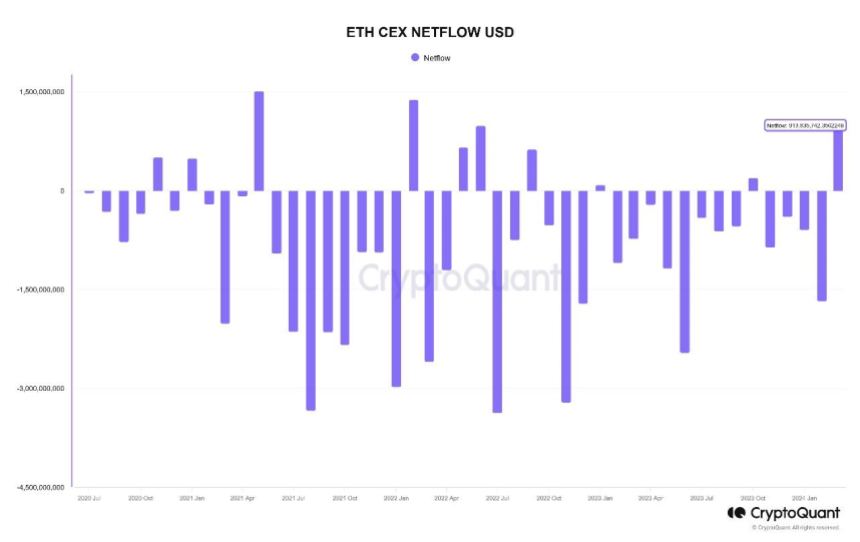
As shown in the chart above, October 2023 was the last time cryptocurrency exchanges witnessed a positive net flow. It is worth noting that there was significant movement of Ethereum tokens out of the centralized platforms in subsequent months up until this month.
Meanwhile, a separate data point that supports the massive exodus of ETH to centralized exchanges has come to light. Popular crypto analyst Ali Martinez revealed on X nearly 420,000 Ethereum tokens (equivalent to $1.47 billion) have been transferred to cryptocurrency exchanges in the past three weeks.
The flow of large amounts of cryptocurrency to centralized exchanges is often considered a bearish sign, as it can be an indication that investors may be willing to sell their assets. Ultimately, this can put downward pressure on the cryptocurrency’s price.
Substantial fund movements to trading platforms could also represent a shift in investor sentiment. It could be a sign that investors are losing faith in a particular asset (ETH, in this case).
Moreover, the recent regulatory headwind surrounding Ethereum specifically accentuates this hypothesis. According to the latest report, the United States Securities and Exchange Commission is considering a probe to classify the ETH token as a security.
As of this writing, the Ethereum token is valued at $3,343, reflecting a 4% price decline over the past /4 hours. According to data from CoinGecko, ETH is down by 11% in the past week.
After a six-week run, altcoins are cooling off, leading some to fear the worst. However, in a post on X, one crypto analyst urges calm, saying the dip is a normal part of any bull market and may even present opportunities for discerning traders and investors.
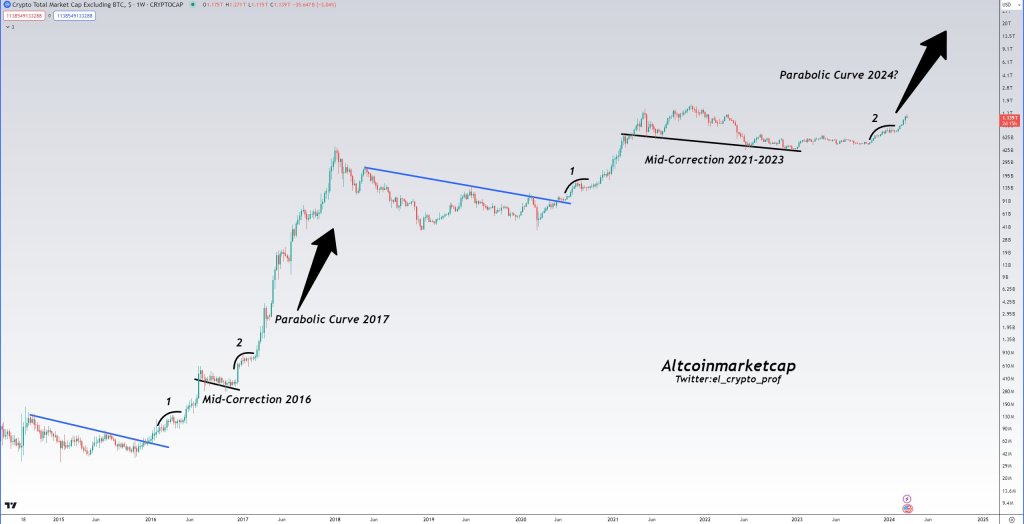
After posting solid gains and rallying to as high as $73,800 on March 13, Bitcoin edged lower on March 14 and continues under pressure when writing. Considering the positive correlation between Bitcoin and altcoins, leading altcoins like Ethereum, XRP, Cardano, and Solana retraced slightly.
Related Reading: Bitcoin Crash Triggered By Failed $1 Billion Hedge Fund Spread Trade: Expert
When writing, Ethereum is far from the $4,090 recorded last week. At the same time, the Solana uptrend has slowed, with $200 proving elusive for optimistic traders. Meanwhile, XRP, despite the high optimism when prices roared higher on March 11, is struggling for momentum and is currently trending lower.
While the altcoin has been drawn down, the total crypto market cap drop and fear creep in have caused the analyst to remain bullish. Despite the correction, the altcoin uptrend remains, and most coins, including Ethereum, Solana, and Cardano, could post more gains.
To illustrate, the crypto community remains upbeat because of Dencun and its potential to enhance Ethereum and the broader layer-2 ecosystem. Ethereum rollup platforms, including Base and Optimism, that have activated Dencun features have seen decentralized applications (dapps) launching on their platforms benefit.
Uniswap Labs, the team behind Uniswap, a leading decentralized exchange, reported that transaction fees on users trading on Optimism have fallen even further after activating Dencun. This reduction in fees may be a catalyst to drive more activity on-chain, propping up prices.
On the other hand, Solana bulls are upbeat. Since September 2023, SOL has been on a sharp uptrend. At spot rates, the coin roared to register fresh 2024 highs.
With this performance, Solana outperforms Bitcoin and other altcoins, including ETH. CoinMarketCap data shows that SOL has risen by 15% in the past week, closely trailing BNB, the native currency of the BNB Chain ecosystem.
Analysts are looking at the upcoming Firedancer upgrade to fortify Solana’s infrastructure further and increase reliability. Meanwhile, regulatory developments in the United States are evolving positively, propping up altcoins, mainly BNB.
Overall, the crypto uptrend remains even with prices cooling off. More importantly, even with falling prices, sentiment remains bullish. In the past week, CoinMarketCap data shows that the Crypto Fear and Greed Index is at “extreme greed” territory.
The dominance war is on. CoinMarketCap data shows that Solana and BNB Chain, two popular smart contracts platforms after Ethereum, are emerging as strong contenders.
In a post on X, one crypto analyst notes that SOL and BNB, the native currencies of Solana and BNB Chain, respectively, have been growing, subsequently expanding the market caps of their respective platforms. However, even with this price uptick, it has yet to attain the 5% level, a target for proponents of the two platforms.
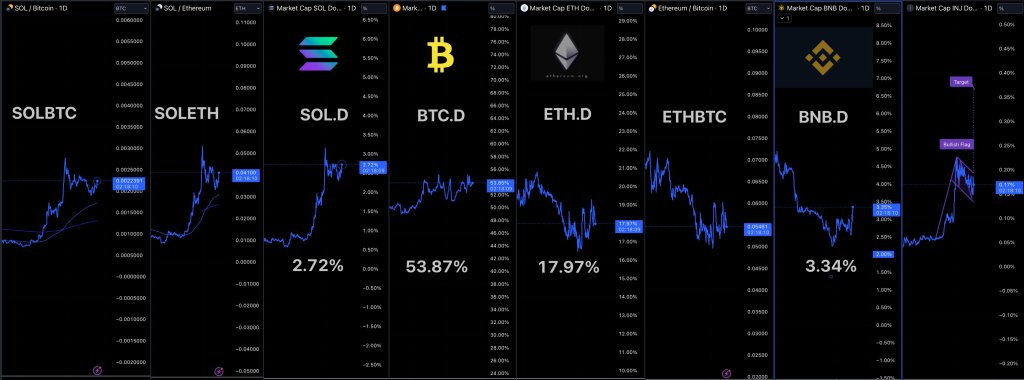
When the analyst shared the screenshot on March 14, BNB Chain, powered by Binance Coin (BNB), held a slight lead with a 3.34% dominance, while Solana trailed behind at 2.72%.
However, Solana has been on a tear. Not only is the coin outperforming Bitcoin and Ethereum, but it has been expanding rapidly, faster than BNB in the past few trading weeks. When writing, CoinMarketCap data shows that SOL is trading above $170, a multi-month high.
Moreover, it is up 11% on the last trading day and 20% in the previous trading week. At this valuation, SOL’s market cap is up 12% to over $75 billion, cementing its position at fifth, trailing BNB.
On the other hand, BNB remains at fourth, behind USDT–the most liquid stablecoin whose market cap stands at over $103 billion. BNB is up 2% the previous day but double digits in the past week of trading. Overall, the lack of inactivity, especially on the last trading day, means its total market cap, at over $90 billion, is stable, only adding 2% on the last day.
When comparing the performances of Solana and BNB, the former has the upper hand. For example, from September 2023, SOL gained over 200% versus BNB. BNB pared losses from January, but the revival in Solana, considering the success of meme coins, means SOL might extend gains in the future.
As the competition intensifies, the future remains uncertain. It’s unclear whether SOL will overtake BNB to claim the second most dominant smart contract spot after Ethereum.
However, at the time of writing, what’s certain is that the spike in on-chain activity on Solana and the unfolding events around the FTX bankruptcy case could bolster SOL prices. Therefore, it’s highly probable that Solana’s dominance might catch up with BNB as the race to the 5% level intensifies.
In November 2023, Binance settled with United States regulators, including the Securities and Exchange Commission (SEC), agreeing to pay a $4.3 billion fine. As part of the deal, their co-founder, Changpeng Zhao, also had to resign as CEO. While BNB prices initially plunged, the token recovered steadily from the $300 level.
Ethereum (ETH) has completed a major software upgrade, Dencun, that promises to make utilizing the network ecosystem more cost-effective. This update specifically targets Layer 2 (L2) networks, such as Arbitrum (ARB), Polygon (MATIC), and Coinbase’s Base, which are interconnected with Ethereum.
With Dencun, transaction costs on these networks have significantly decreased, with fees dropping from dollars to cents or even fractions of a cent.
Considered the most significant change in Ethereum’s end-user experience, the Dencun upgrade is expected to foster the development of new applications and services by significantly reducing expenses.
As NewsBTC reported on Tuesday, the update introduces a new data storage system, departing from the traditional approach of storing Layer 2 data on Ethereum itself. Adopting a new “blobs” repository reduces data storage costs since information is warehoused for only about 18 days instead of indefinitely.
One of the notable benefits of the Dencun upgrade lies in its impact on decentralized exchanges (DEXs) and gas costs. For instance, projected gas costs for popular Layer 2 networks, such as Arbitrum, Optimism, and Coinbase’s Base, are set to be significantly reduced.
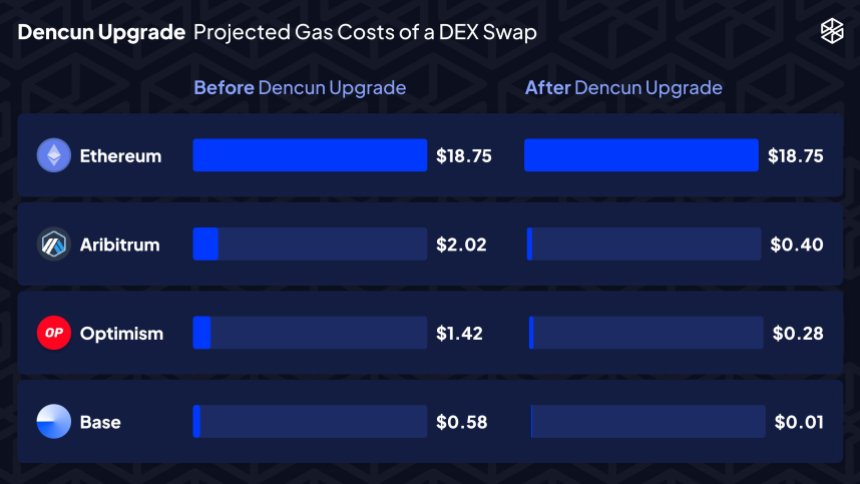
The projected savings translate into a reduction of Arbitrum’s swaps from $2.02 to $0.40, Optimism’s swaps from $1.42 to $0.28, and Coinbase’s Base swaps from $0.58 to $0.01, emphasizing the pivotal role of this upgrade.
As the upgrade was successfully launched on the mainnet, Tim Beiko, Ethereum Foundation core developer, expressed his satisfaction with the work accomplished and claimed:
Dencun is both the most complex fork we’ve shipped since the Merge, and tied for “most total EIPs in a fork” with Byzantium. There were more teams than ever involved in the process, and it somehow all worked out smoothly…! Grateful to work with all of them, onto the next one.
Layer 2 network Arbitrum has provided insights into the upgrade process. It will take around one to two hours for blob transactions to commence posting and for the new pricing changes specified by EIP-4844 to come into effect.
ArbOS Atlas, an upgrade that supports Arbitrum Chains, will introduce further fee reductions for Arbitrum One, set to be activated on March 18th. The updated configurations include a reduction in the Layer 1 (L1) surplus fee from 32 gwei to 0 per compressed byte and a reduction in the L2 base fee from 0.1 gwei to 0.01 gwei.
The Dencun upgrade unlocks cost-saving opportunities for Layer 2 networks and addresses congestion concerns by freeing up more space on the Ethereum network for additional transactions. While the upgrade offers enhanced efficiency, it does come at the cost of no longer retaining a complete record of all data indefinitely.
However, as Layer 2 networks embrace this new update to the Ethereum ecosystem, the stage is set for accelerated adoption, usage, and broader accessibility within the Ethereum community and its underlying protocols.
Dencun Upgrade Fails To Propel ETH Above $4,000
Despite the successful upgrade, ETH’s price remains unaffected, continuing to consolidate below the $4,000 threshold. The token attempted to surpass this crucial resistance level on Monday and Tuesday but failed to sustain its position above it.
For over 24 hours now, ETH has been trading between $3,930 and $3,970. Nevertheless, it’s worth noting that ETH has maintained its upward momentum, with gains exceeding 18% over the past fourteen days and nearly 60% over the past thirty days.
Additionally, introducing the Dencun upgrade is expected to drive increased demand for ETH, potentially sparking a renewed uptrend that could bridge the gap between current trading prices and its previous all-time high (ATH) of $4,878, achieved in November 2021.
Featured image from Shutterstock, chart from TradingView.com
Ethereum is currently looking to gain a strong footing above the $4,000 price level as bullish momentum continues to dominate. According to crypto analyst Ali Martinez, this bullish momentum could continue and Ethereum could as well reach $5,000 very soon.
Ali Martinez made this known while citing data from IntoTheBlock, noting that the second biggest cryptocurrency still has room to run to $5,000, albeit a small resistance around $4,522 to $4,646.
Ethereum’s momentum has been building for weeks amidst a broader crypto market increase, which has seen many cryptocurrencies reach new highs. The price of Ethereum has increased by 53% in the past 30 days alone, leaving investors to wonder how high it can keep going and whether it can follow in Bitcoin’s footsteps and attain a new all-time high.
In a social media post on X, Martinez noted a $5,000 price point is in the books “as resistance thins.” However, a key hurdle remains at $4,522-$4,646, where 600,000 addresses hold 1.63 million ETH. Despite this resistance hurdle, Martinez believes a $5,000 price point is inevitable while noting that the only question left is when this will manifest.
#Ethereum path to $5,000 looks increasingly clear, as resistance thins. The key hurdle? A supply zone at $4,522-$4,646, where 600,000 addresses hold 1.63 million $ETH. It’s not a matter of if, but when! pic.twitter.com/LMvw3kjrEW
— Ali (@ali_charts) March 11, 2024
The analyst made this prediction using IntoTheBlock’s “In/Out of the Money Around Price” metric, which tracks the number of holders making money at the current price. Interestingly, the metric indicated that 7.64 million ETH, representing 75.95% of the volume bought between $3,428 and $4,646, are making money at the current price.
Ethereum is trading at $4,058 at the time of writing on the back of a minor correction after reaching a two-year high of $4,084. If bullish momentum continues and ETH can close the week above $4,175, that could pave the way for a quick move to $4,500 and potentially past its current all-time high of $4,891 to set a new one.
Current price action shows Ethereum has created a support around $3,950 during its move up to $4,000. As long as this price level continues to hold, the overall bullish trend remains intact. But a break below $3,920 could signal a deeper correction to $3,800.
Increased blockchain activity on layer-2 networks has pushed gas fees to new highs. As a result, developers are getting ready to roll in a Dencun upgrade, which is supposed to usher in a new era of cheaper fees. The Dencun upgrade is the first change to Ethereum’s blockchain code in over a year.
The Ethereum liquidity staking protocol Rocket Pool is on the brink of a massive transformation with the incoming Dencun upgrade. As one community advocate points out, this change is primarily due to the enhancements the Houston upgrade will tag.
In a recent post on X, the advocate explained that the Dencun upgrade, scheduled to go live in mid-March 2024, will pave the way for the implementation of the Houston upgrade. The Houston upgrade, in turn, aims to improve Rocket Pool’s scalability and efficiency.
The Dencun upgrade must first be successfully implemented so that the Houston enhancements can take effect and improve Rocket Pool’s performance.
This hard fork update requires all Ethereum node operators to upgrade their software. Once the network is updated, developers predict that transaction costs, particularly in layer-2 networks, will decrease significantly.
However, the Dencun upgrade will also execute a crucial enhancement, Ethereum Improvement Proposal (EIP) 4788. This proposal is designed to optimize communication between the execution layer, where all smart contracts and transactions occur, and the consensus layer, which includes validators like Rocket Pool.
A crucial aspect of this proposal is enabling the execution layer to access consensus layer information without needing third-party oracles, thereby enhancing the mainnet’s security and efficiency.
With the activation of the Houston upgrade, Rocket Pool users can anticipate a series of enhancements designed to improve their experience.
Once Houston goes live, the protocol will automatically lower the minimum ETH staking amount, allowing more users to stake. Additionally, introducing a delegated mini-pool contract will streamline the distribution of fees and rewards. In Rocket Pool, a mini pool is a virtual pool combining all the ETH from stakers.
However, over time, the activation of EIP-4788 allows Rocket Pool to innovate on ETH staking. Looking at the price chart, this expectation has been well received.
So far, RPL, the native token of the liquidity staking platform, has been ripping higher. On March 6, the token broke above February highs above $33. Traders expect bulls to build on recent gains, pushing the token towards January 2024 highs of around $40.
When written on March 7, the token was up nearly 110% from its October 2023 lows. Even so, RPL has yet to recover from the bear run of 2022. In April 2023, the token rose to as high as $65.
The Ethereum Dencun upgrade is fast approaching and there have already been notable developments leading up to it. Besides the price of ETH rising to new two-year highs, there has been a significant increase in the amount of ETH that has been burned so far.
The Ethereum burn, which was brought with the EIP-1559 upgrade, has been ramping up over the past year. The ETH burned from fees on the blockchain quickly crossed the $100 million mark, and has now climbed to a new milestone.
According to Ultrasound Money, a website dedicated to tracking the performance of Ethereum since EIP-1559 was implemented, there have now been over 1.5 million ETH burned. A more accurate figure is 1,502,518.84 ETH at the time of writing, which is more than $5.6 billion at current prices.
The number of burned ETH has also greatly surpassed that of ETH issued, which means that the network has turned deflationary. Compared to the 1,502,518.84 ETH burned, there have been only 1,089,809.20 ETH issued in the same time period. This shows that the supply has not increased despite the new issuance, and ETH already in circulation is being burned as well.
At the time of the upgrade in 2022, the total Ethereum supply was 120,521,245. However, since then, the burn has been slowly eating into this figure and is currently sitting at 120,108,332 ETH. This means that the ETH supply has reduced by 412,706 ETH worth $1.55 billion since 2022.
The Ethereum Dencun upgrade is the latest in a long line of upgrades that have taken place in an effort to make it a better network. This upgrade is expected to come with a number of improvements for the network, including boosting its efficiency and capacity.
It was launched on all testnets last week which is expected to be the final phase before the launch. The launch itself has been scheduled to take place less than a week from now on March 13. Once completed, an increase in block space is expected to follow.
Presently, the ETH price is performing quite nicely leading up to the upgrade. It recently touched $3,900 for the first time since 2022, and while there has been a slight retracement, the altcoin continues to trend high above $3,700 at the time of writing.
Ye Zhang, the co-founder of Scroll, a layer-2 project using zero-knowledge proof, is cautiously optimistic about the upcoming Dencun upgrade. In a post on X, Zhang pointed out Dencun’s potential benefits, particularly the low transaction fees.
However, in the same post, the co-founder highlighted the likely challenges it could present for existing layer-2 scaling solutions using roll-ups.
Ethereum developers plan to implement Dencun in mid-March. Implementing the Ethereum Improvement Proposal (EIP)-4844 is a big part of this hard fork. With this execution, the proposal will introduce a new “blob-carrying transaction” feature.
What’s unique about these transactions is that they allow users to cheaply attach blobs, which are large amounts of data, compared to traditional Ethereum transactions.
Based on observations from the Goerli testnet, Zhang anticipates blobs to be 3-5 times cheaper than traditional call data on Ethereum. Accordingly, the vast difference means innovative developers can come up with blob-inscriptions. These inscriptions will effectively compete with layer-2 solutions like Arbitrum or Optimism leveraging roll-ups.
This possibility cannot be discounted because, in essence, EIP-4844 aims to reduce layer-2 transactions through blob transactions. Effectively, the proposal means the foundation of Blob inscriptions.
This solution takes a different approach but could take on roll-up platforms if widely adopted. It will be the case if users transacting large chunks of data realize the advantage of going the blob inscription route.
Even so, roll-ups will carry distinct advantages over blob inscriptions. A notable one is the superior scalability of roll-ups. These solutions can inherently process more transactions every second. Additionally, they are secure since they inherit security from the Ethereum mainnet.
Still, until after Dencun is implemented, the impact of EIP-4844 will be thoroughly measured. Overall, the Ethereum and layer-2 communities are ecstatic for the upgrade, expecting it to thrust ETH even higher in the current bull run.
Ethereum is trading above $3,800. It has been up by double digits in the past week, and experts are predicting even more gains in the days ahead.
Related Reading: Analyst Cites Key Indicators That Signal Bitcoin Correction
In the medium term, bulls target $5,000, around the all-time high.
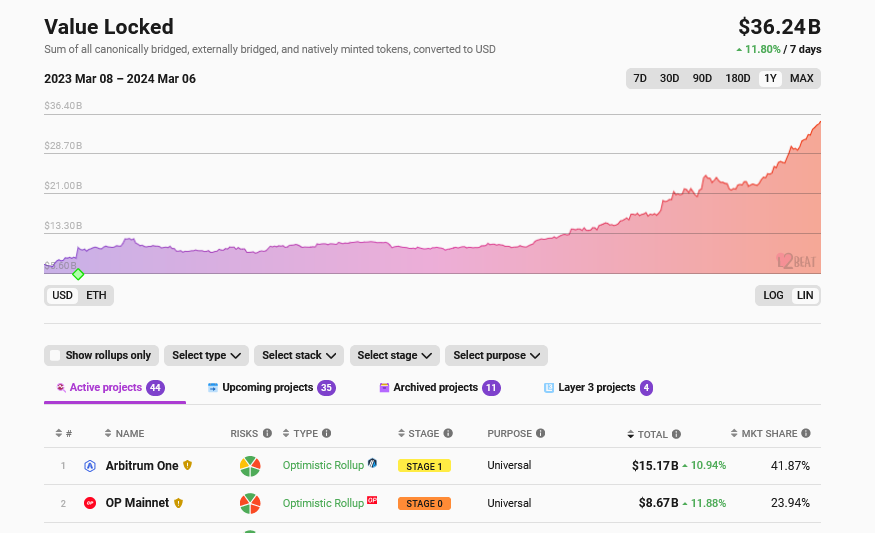
Amid the boom in ETH and crypto prices, interest in Ethereum layer-2 solutions continues to expand. The latest L2Beat data shows that Arbitrum, Optimism, and other alternatives manage over $36 billion. Arbitrum, enjoying its first-move advantage, manages nearly $16 billion.
After Bitcoin (BTC) recorded a new all-time high (ATH), Ethereum (ETH) rallied above $3,800 before the price crashed over 10%. The second-largest cryptocurrency has recovered from the dip and reached $3,900 momentarily for the first time in over two years.
On Thursday, Bitcoin reached a crucial milestone after breaking above $69,000 and recording a new all-time high (ATH). Before the euphoria was over, the flagship cryptocurrency’s price started to drop, trading as low as $60,000. Since then, BTC’s price has recovered to hover between the $66,000-$67,000 price range.
Fueled by the bullish sentiment, Ethereum rallied above $3,800 before suffering a considerable price drop. The ‘king of altcoins’ lost momentum and shredded about 12% of its price to trade at a price as low as $3,360, according to CoinMarketCap data.
After the dip was done, ETH started to show a recovery alongside Bitcoin. As reported by NewsBTC, a crucial resistance level to clear during this recovery was $3,600. Ethereum surpassed this support level and has maintained its price above the $3,800 range during the last 4 hours.
JUST IN: $3,900 $ETH
— Watcher.Guru (@WatcherGuru) March 6, 2024
Ethereum reached the $3,800 support level twice in the last 24 hours. This price range was not seen since January 2022, and the regained bullish momentum propelled the token’s price to a higher milestone.
Ethereum hit $3,900 for the first time since December of 2021. The biggest altcoin briefly soared to $3,901 before falling to the $3,850 price range.
At the time of writing, ETH is trading at $3,834, representing a 1.6% price drop in the last hour and a 2% increase from 24 hours ago. Similarly, the token exhibits green numbers on longer timeframes.
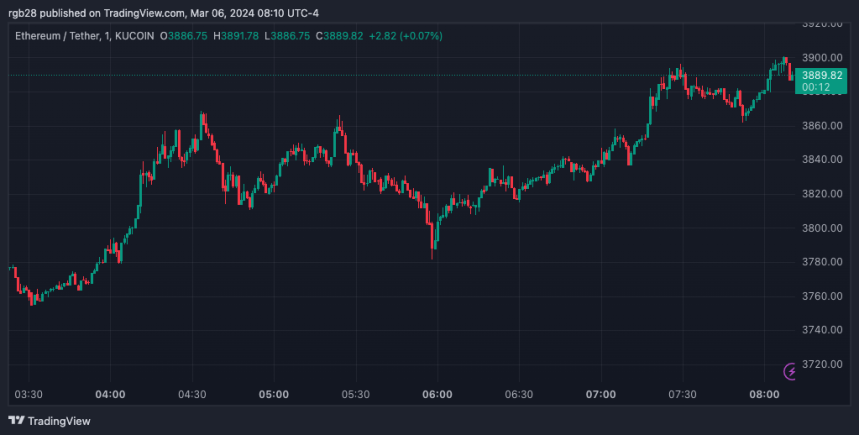
Ethereum’s price performance has surged almost 16% in the past week, 65% in the last month, and an impressive 145% in one year.
ETH’s market capitalization increased 1.55% to $459.7 million on the last day. Its daily trading volume has increased by 58%, with $52.16 billion in market activity in the previous 24 hours.
Many analysts have forecasted that ETH’s rally is far from over. Analyst Altcoin Sherpa predicted that Ethereum could reach $4,000 when it breaks through the $3,000 price barrier.
Ethereum’s rally seems to be fueled not only by Bitcoin’s momentum but also by the general market dynamics. The date for the Dencun upgrade is approaching, and this update is expected to bring several technical improvements to Ethereum’s infrastructure,
Moreover, the possibility of Ether-based spot exchange-traded funds (ETF) being approved by the US Securities and Exchange Commission (SEC) in May has built expectations for Ether and the blockchain’s ecosystem.
Pseudonym trader Ash Crypto suggested to his Telegram subscribers that the price correction experienced after Bitcoin’s new ATH was not a “reason to panic.”

Related Reading: Ethereum Price Follows Bitcoin Surge, Why $4K Is Just A Matter of Time
The trader considers that the “late long flush to cut all the leverage” was expected and that a soon-to-come stabilization in BTC’s price will propel the run of ETH and all altcoins. Similarly, he announced the ‘incoming alt season’ after the price of ETH hit $3,900 and suggested that Ethereum’s next support level will be $4,200.
$ETH JUST MADE A NEW HIGH
$4,200 IS COMING NEXT !
GET READY FOR ALTSEASON pic.twitter.com/ZLirlerVDJ
— Ash Crypto (@Ashcryptoreal) March 6, 2024
The Ethereum Foundation, a non-profit organization, has initiated an unexpected ETH sell-off to a single address, prompting speculation about a potential market peak.
On Monday, March 4, Blockchain analytics platform LookOnChain revealed a series of transactions executed by a wallet address related to the Ethereum Foundation. Sharing a screenshot of the transaction details on X (formerly Twitter), LookOnchain disclosed that the Ethereum Foundation had initiated three ETH transactions to a single wallet address identified as “Cumberland Forwarder”.
Among these transfers, two involved selling off 500 ETH each, while the third recorded a transaction amount of 0 ETH. At the time of writing the price of Ethereum is trading at $3,684.95 according to CoinMarketCap. This price puts the value of the Ethereum Foundation’s 1000 ETH sell-offs at over $3.68 million.
It’s uncertain whether this unexpected sell-off indicates a shift in the foundation’s perspective on Ethereum’s current valuation, as the foundation is known for selling ETH tokens during tops. Additionally, the timing of the transfers could be an indication of a peak in Ethereum’s price, which often precedes a significant price correction.
Including the Ethereum Foundation, there have been other major ETH transfers made by investors. Earlier in January, bankrupt cryptocurrency company Celsius Network initiated a massive sell-off worth about $125 million ETH. Following this large-scale transfer, Ethereum’s price experienced a major decline.
With the price of Ethereum slowly approaching its peak value, if a similar sell-off phase occurs, it could potentially trigger a shift in market sentiment, pushing investors to opt for other major cryptocurrencies as they attempt to diversify their portfolios and avoid risks.
Recently, Ethereum has been witnessing significant gains, driving its price closer to its previous all-time high of $4,379 in May 2021. Notably, the cryptocurrency has been aggressively following Bitcoin’s recent bullish uptrend, reinforcing its position as the second-largest cryptocurrency in the space.
Various analysts have consistently made bullish predictions about the price of Ethereum, with the majority expecting the cryptocurrency to surge above $5,000 soon. Considering the multiple upgrades and developmental activities ongoing within the Ethereum blockchain, a price surge to $4,000 seems probable.
In the advent that Ethereum reaches its “top in”, the cryptocurrency may undergo a sell-off phase, as investors seek to maximize profits by cashing out their investments. This could lead to a price reversal, with persistent selling pressures diminishing demand and instigating Fear, Uncertainty and Doubt (FUD) among traders and investors.
As Bitcoin surges towards its all-time high (ATH) of nearly $70,000, analysts are closely watching Ethereum, the world’s second-largest cryptocurrency, wondering how quickly it will follow suit and break its record ATHs of approximately $5,000 printed in late 2021.
One analyst, posting on platform X, highlights the difference in the two coins’ positions compared to the last time Bitcoin broke above 2017 highs of $20,000 in December 2020. Then, Ethereum was trading at $600, a full 57% below its previous ATH of about $1,400.
As Bitcoin nears its record peak of around $70,000 registered in December 2021, Ethereum is approaching $4,000. However, the difference between then and now is that ETH is about 36% shy of its ATH of around $5,000.
The question in the analyst’s mind is, considering historical performance, how fast ETH will ease past $5,000. When Bitcoin broke above $20,000 in late December 2020, the analyst notes that it took approximately two months for ETH to sweep past $1,400 and record new highs.
The boom after this breakout lifted ETH to around $5,000, accelerated mainly by retail activities cycling around decentralized finance (DeFi) and non-fungible token (NFT) minting.
Looking at the Ethereum price action in the daily chart, it is clear that buyers are in control. ETH prices, CoinMarketCap data reveals, are up roughly 7% in the past 24 hours and 15% in the previous week. However, how quickly ETH might repeat the prior 2020-2021 feat remains to be seen.
Like in the past, the Ethereum price action benefits from the Bitcoin expansion. The revival in Bitcoin prices has seen capital flow to Ethereum, priming its broader ecosystem comprising DeFi and NFT protocols. DeFiLlama data shows that Ethereum manages over $56 billion worth of assets.
Notably, almost all top DeFi protocols in Ethereum, including Lido, Maker, Uniswap, and EigenLayer, have posted strong inflows in the past day, week, and month.
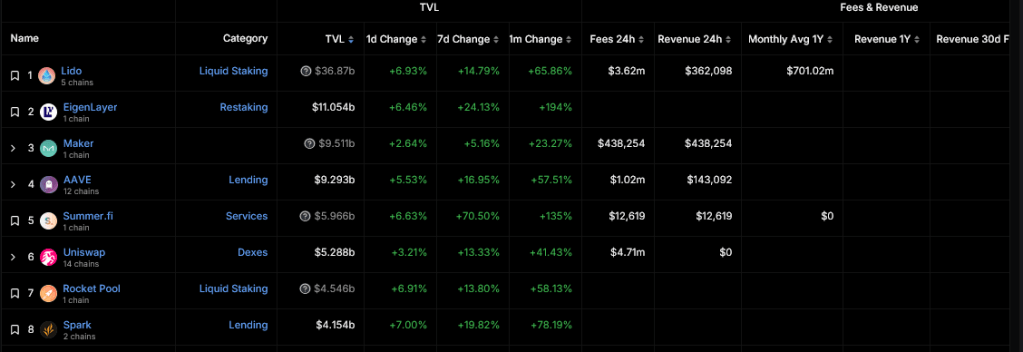
Aside from market-related factors, Ethereum prices are also steadied by hopes around the eventual approval of a spot Ethereum exchange-traded fund (ETF). BlackRock is among the leading asset managers to file with the United States Securities and Exchange Commission (SEC).
However, the agency postponed a ruling on BlackRock’s application for a spot Ethereum ETF, citing concerns about the network’s new proof-of-stake consensus mechanism. The SEC expressed worries that staking, a core aspect of proof-of-stake, could create opportunities for manipulation.
The clear reservation regarding proof-of-stake cast a shadow on Ethereum’s near-term outlook despite the current uptick in prices. Still, the community finds relief realizing that the Commission rejected approving a spot Bitcoin ETF for roughly ten years before January 2024.
In comments likely to resonate with crypto fans, Hayden Adams, the founder of Uniswap, a leading decentralized exchange (DEX), predicts that network fees will eventually become a background expense for users, much like server costs are today for top centralized applications running on Amazon Web Service and other platforms.
Taking to X, Adams envisioned a future where decentralized applications (dapps) seamlessly cover network fees on behalf of users. This approach, the inventor adds, aligns with how server costs are currently handled in the current setup, especially among operators of common applications like X or Facebook.
Server costs are often considered a hidden expense in the overall business model. However, this can cost millions of dollars monthly, depending on the app’s popularity.
Presently, the dream of low-fee transactions remains out of reach for some blockchains, particularly Ethereum, the dominant platform for smart contracts. Ethereum is a legacy blockchain that recently shifted from a proof-of-work to proof-of-stake consensus.
However, while this was a major shift, the network still struggles with scaling challenges. At optimum, Ethereum can only process 15 transactions every second. Comparing this with current demand only means “gas fees” must be high to incentivize the validator to include transactions in the next block.
This high “gas fee” continues to be a major pain point, leading some projects to migrate to alternative networks with faster transaction speeds and lower fees. Solana, a high-throughput blockchain, and layer-2 scaling solutions like Arbitrum have emerged as popular destinations for these migrating projects. This trend is particularly evident with the recent surge of meme coins like BONK and WIF, which have seen significant growth on Solana.
Unlike Ethereum, Solana and layer-2 platforms relying on Ethereum for security boast higher throughput and negligible gas fees. Accordingly, more meme coin projects are launching on these networks. Here, users can transact without considering the implication of gas fees. In recent weeks, top meme coins, besides PepeCoin (PEPE) or Dogecoin (DOGE), have been launching on Solana.
Ethereum will implement the Dencun Upgrade in mid-March to combat its scaling woes. The update aims to reduce costs for users interacting with layer-2 solutions significantly. However, this upgrade is just one of the many Ethereum developers plan to implement over time.
Eventually, the proof-of-stake network aims to scale processing speeds, allowing it to execute millions of transactions every second through innovations like Sharding.
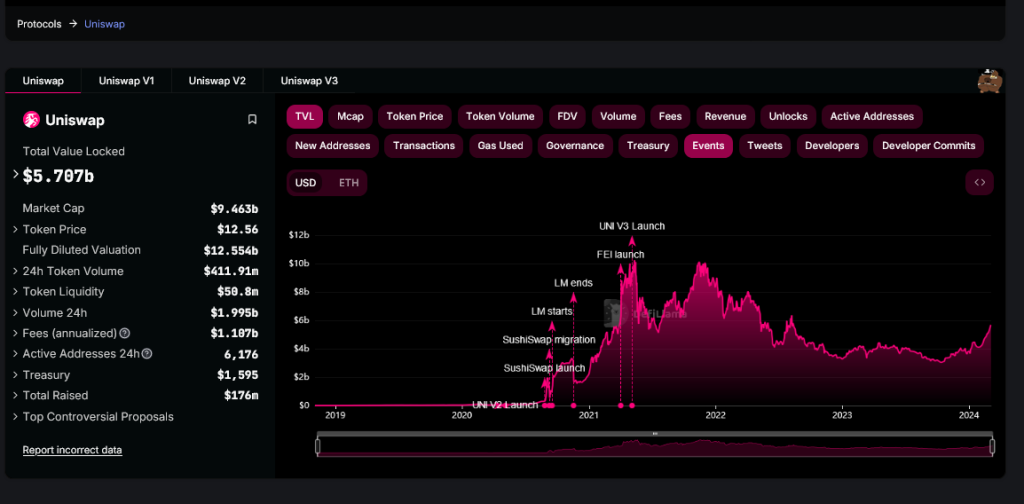
Uniswap continues to lead in popularity, looking at assets under management. So far, Uniswap developers have deployed its solution across other blockchains and layer-2 options, including Arbitrum and the BNB Chain.